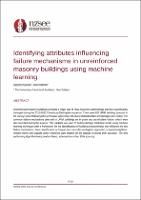| dc.contributor.author | Kaushal, Saanchi | |
| dc.contributor.author | Ingham, Jason | |
| dc.date.accessioned | 2021-06-22T04:02:07Z | |
| dc.date.available | 2021-06-22T04:02:07Z | |
| dc.date.issued | 2021-04-14 | |
| dc.identifier.uri | https://repo.nzsee.org.nz/xmlui/handle/nzsee/2430 | |
| dc.description.abstract | Unreinforced masonry buildings comprise a major part of New Zealand's built heritage and were significantly damaged during the 2010-2011 Canterbury Earthquake sequence. There were 627 URM building assessed in the surveys done following the earthquake where their structural characteristics and damages were noted. The common failure mechanisms observed in URM buildings are in-plane and out-of-plane failure, which were also recorded during the surveys. This database was used to build a damage prediction model using machine learning techniques with a framework for the identification of building characteristics that influence the two failure mechanisms. Four classification techniques such as multiclass logistic regression, k-nearest neighbour, random forest and support vector machines were trialled on the dataset, to assess their accuracy. The best performing algorithm being random forest, achieved more than 65% accuracy. | |
| dc.language.iso | en | |
| dc.publisher | New Zealand Society for Earthquake Engineering | |
| dc.relation.ispartofseries | 2021;0086 | |
| dc.subject | Improving understanding of seismic hazard and risk | |
| dc.subject | Engineering assessments for general purposes and potentially earthquake-prone buildings | |
| dc.subject | Innovative approaches in seismic design and assessment | |
| dc.title | Identifying attributes influencing failure mechanisms in unreinforced masonry buildings using machine learning | |
| dc.type | Article | |

